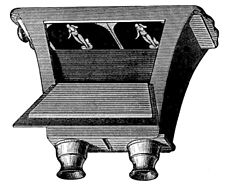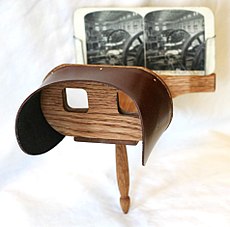





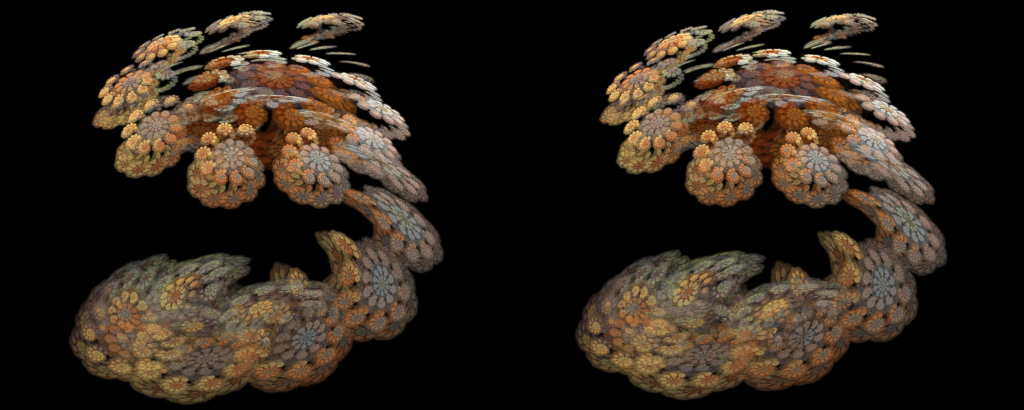
Beck Stereoscope – Antique and Vintage Cameras
ــــــــــــــــــــــــــــــــــــــــ
Stereoscope
A stereoscope is a device for viewing a stereoscopic pair of separate images, depicting left-eye and right-eye views of the same scene, as a single three-dimensional image.
A typical stereoscope provides each eye with a lens that makes the image seen through it appear larger and more distant and usually also shifts its apparent horizontal position, so that for a person with normal binocular depth perception the edges of the two images seemingly fuse into one “stereo window”. In current practice, the images are prepared so that the scene appears to be beyond this virtual window, through which objects are sometimes allowed to protrude, but this was not always the custom. A divider or other view-limiting feature is usually provided to prevent each eye from being distracted by also seeing the image intended for the other eye.
Most people can, with practice and some effort, view stereoscopic image pairs in 3D without the aid of a stereoscope, but the physiological depth cues resulting from the unnatural combination of eye convergence and focus required will be unlike those experienced when actually viewing the scene in reality, making an accurate simulation of the natural viewing experience impossible and tending to cause eye strain and fatigue.
Although more recent devices such as Realist-format 3D slide viewers and the View-Master are also stereoscopes, the word is now most commonly associated with viewers designed for the standard-format stereo cards that enjoyed several waves of popularity from the 1850s to the 1930s as a home entertainment medium.
Devices such as polarized, anaglyph and shutter glasses which are used to view two actually superimposed or intermingled images, rather than two physically separate images, are not categorized as stereoscopes
الاستريوسكوب المجسام
من ويكيبيديا، الموسوعة الحرة
قديم زايس جيب المجسام مع اختبار صورة الأصلية
المجسام هو جهاز للعرض زوج مجسمة من الصور منفصلة، والتي تصور وجهات النظر العين اليمنى واليسرى والعين من نفس المكان، كما واحدة صورة ثلاثية الأبعاد.
يوفر المجسام نموذجي كل عين مع العدسة التي تجعل الصورة التي يراها من خلال ذلك تبدو أكبر وأكثر بعدا وعادة أيضا تحولات موقفها الأفقي واضح، بحيث لشخص مع العادي مجهر عمق الإدراك حواف الصورتين على ما يبدو الصمامات في واحد "نافذة ستيريو". في الممارسة الحالية، يتم إعداد الصور بحيث يظهر المشهد أن تكون خارج هذا الإطار الافتراضي، يتم من خلالها السماح الأشياء أحيانا تبرز، ولكن هذا لم يكن دائما العرف. وعادة ما يتم توفير مقسم أو غيرها من ميزة الحد بغية منع كل عين من الهاء أيضا رؤية الصورة المخصصة للعين الأخرى.
يمكن لمعظم الناس، مع الممارسة وبعض الجهد، وعرض صورة مجسمة مزدوجة في 3D بدون مساعدة من المجسام، ولكن العظة عمق الفسيولوجية الناتجة عن الجمع بين غير طبيعي من التقارب العين والتركيز المطلوب أن يكون على عكس تلك التي واجهتها عند عرض فعلا المشهد في الواقع، مما يجعل محاكاة دقيقة من تجربة المشاهدة الطبيعية المستحيل وتميل إلى أن يسبب إجهاد العين والتعب.
على الرغم من أن المزيد من الأجهزة الحديثة مثل المشاهدين شريحة الواقعية الشكل 3D وترى المدرسة هي أيضا المجسامات، والكلمة هي الآن الأكثر شيوعا المرتبطة المشاهدين مصممة للبطاقات الاستمارة الموحدة للستيريو التي تتمتع عدة موجات من شعبية من 1850s في إلى 1930s وسيلة الترفيه المنزلي.
أجهزة مثل الاستقطاب، النقش ومصراع نظارات والتي تستخدم لعرض اثنين من فرضه الواقع أو تتداخل الصور، بدلا من اثنين من الصور المنفصلة من الناحية الفيزيولوجية، لا يتم تصنيفها على أنها المجسامات
History
Wheatstone stereoscope
The earliest type of stereoscope was invented by Sir Charles Wheatstone in 1838.[1][2][3] It used a pair of mirrors at 45 degree angles to the user’s eyes, each reflecting a picture located off to the side. It demonstrated the importance of binocular depth perception by showing that when two pictures simulating left-eye and right-eye views of the same object are presented so that each eye sees only the image designed for it, but apparently in the same location, the brain will fuse the two and accept them as a view of one solid three-dimensional object. Wheatstone’s stereoscope was introduced in the year before the first practical photographic process became available, so drawings were used. This type of stereoscope has the advantage that the two pictures can be very large if desired.
المجسام يتستون
اخترع أقرب نوع من المجسام السير تشارلز ويتستون في 1838. [ 1 ] [ 2 ] [ 3 ] وهي تستخدم زوج من المرايا في زوايا 45 درجة إلى عيني المستخدم ، والتي تعكس كل صورة الواقعة قبالة إلى الجانب. فقد أظهرت أهمية مجهر عمق الإدراك من خلال إظهار أنه عندما تم عرض صورتين محاكاة جهات النظر اليسرى والعين واليمين العين من نفس الكائن بحيث كل عين ترى فقط الصورة مصممة لذلك ، ولكن على ما يبدو في نفس الموقع ، والدماغ سوف صهر اثنين و يقبلهم وجهة نظر من وجوه واحدة صلبة ثلاثي الأبعاد . وقدم المجسام يتستون في السنة قبل أن تصبح أول عملية التصوير العملية المتاحة ، لذلك استخدمت رسومات . هذا النوع من المجسام لديه ميزة أن الصورتين يمكن أن تكون كبيرة جدا إذا رغبت في ذلك .
Brewster stereoscope
Contrary to a common assertion, David Brewster did not invent the stereoscope, as he himself was often at pains to make clear.[4] A rival of Wheatstone, Brewster credited the invention of the device to a Mr. Elliot, a “Teacher of Mathematics” from Edinburgh, who, according to Brewster, conceived of the idea as early as 1823 and, in 1839, constructed “a simple stereoscope without lenses or mirrors”, consisting of a wooden box 18 inches long, 7 inches wide and 4 inches high, which was used to view drawn landscape transparencies, since photography had yet to be invented.[5] Brewster’s personal contribution was the suggestion to use lenses for uniting the dissimilar pictures in 1849; and accordingly the lenticular stereoscope (lens based) may fairly be said to be his invention.[6] This allowed a reduction in size, creating hand-held devices, which became known as Brewster Stereoscopes, much admired by Queen Victoria when they were demonstrated at the Great Exhibition of 1851.[7]
بروستر من نوع قناع مجسمة المحمولة، J. فلوري - Hermagis، 1870. المتحف الوطني للعلوم والتكنولوجيا ليوناردو دا فينشي، ميلان.
وخلافا لتأكيد مشترك، اخترع ديفيد بروستر فعل المجسام لا، كما انه هو نفسه كان في كثير من الأحيان جهدا كبيرا لتوضيح. [4] ومنافس من يتستون، الفضل بروستر اختراع جهاز للسيد إليوت، في "مدرس الرياضيات "من ادنبره الذي، وفقا لبروستر الوظيفي، تصور الفكرة في وقت مبكر من عام 1823، وفي عام 1839، شيدت" المجسام بسيطة بدون العدسات أو المرايا "، تتكون من صندوق خشبي 18 بوصة طويلة، 7 بوصة و 4 بوصات . العالية، والتي كانت تستخدم لعرض المشهد رسمها الشفاف، منذ زيارتها التصوير بعد أن اخترع [5] وكانت مساهمة شخصية بروستر على اقتراح لاستخدام العدسات لتوحيد صور متباينة في 1849. وتبعا لذلك المجسام عدسي (عدسة القائم) قد حد ما يمكن ان يقال ان صاحب الاختراع. [6] وهذا ما سمح انخفاض في حجم، وخلق الأجهزة المحمولة باليد، والتي أصبحت تعرف باسم المجسامات بروستر، يحظى باعجاب كبير من قبل الملكة فيكتوريا عندما كانوا تظاهر في معرض العظمى من عام 1851. [7]
Brewster was unable to find in Britain an instrument maker capable of working with his design, so he took it to France, where the stereoscope was improved by Jules Duboscq who made stereoscopes and stereoscopic daguerreotypes, and a famous picture of Queen Victoria that was displayed at The Great Exhibition.[6] Almost overnight a 3D industry developed and 250,000 stereoscopes were produced and a great number of stereoviews, stereo cards, stereo pairs or stereographs were sold in a short time. Stereographers were sent throughout the world to capture views for the new medium and feed the demand for 3D.[8] Cards were printed with these views often with explanatory text when the cards were looked at through the double-lensed viewer, sometimes also called a stereopticon, a common misnomer.
كان بروستر غير قادر على العثور في بريطانيا صانع أداة قادرة على العمل مع تصميمه ، لذلك فإنه يعتبر ل فرنسا ، حيث تم تحسين المجسام جول دوبوسك الذي جعل المجسامات و داجيرية مجسمة ، وصورة شهيرة للملكة فيكتوريا التي تم عرضها في معرض العظمى . [ 6 ] تقريبا بين عشية وضحاها صناعة 3D وضعت و أنتجت 250000 المجسامات وعدد كبير من stereoviews ، بطاقات ستيريو ، أزواج ستيريو أو stereographs بيعت في وقت قصير . وأرسلت Stereographers في جميع أنحاء العالم للقبض على وجهات النظر ل هذه الوسيلة الجديدة وتغذية الطلب على 3D . [ 8 ] وطبعت بطاقات مع هذه الآراء في كثير من الأحيان مع نص توضيحي عندما كان ينظر البطاقات في خلال المشاهد بعدسات المزدوج ، وأحيانا تسمى أيضا stereopticon ، وهي تسمية خاطئة شائعة .
Holmes stereoscope
In 1861 Oliver Wendell Holmes created and deliberately did not patent a handheld, streamlined, much more economical viewer than had been available before. The stereoscope, which dates from the 1850s, consisted of two prismatic lenses and a wooden stand to hold the stereo card. This type of stereoscope remained in production for a century and there are still companies making them in limited production currently. It is primarily American, although it is often named “Mexican stereoscope.”[9]
Modern use
In the mid-20th century the View-Master stereoscope (patented 1939), with its rotating cardboard disks containing image pairs, was popular first for ‘virtual tourism’ and then as a toy. In 2010, Hasbro started producing a stereoscope designed to hold an iPhone or iPod Touch, called the My3D. In 2014, Google released the template for a papercraft stereoscope called Google Cardboard. Apps on the mobile phone substitute for stereo cards. The underlying technology is otherwise unchanged from earlier stereoscopes.
Several fine arts photographers and graphic artists have and continue to produce original artwork to be viewed using stereoscopes.
هولمز المجسام
المجسام هولمز، الشكل الأكثر شعبية من المجسام القرن ال19
في عام 1861 أنشأت أوليفر وندل هولمز وعمدا لم براءة يده، مبسطة، وأكثر من ذلك بكثير اقتصادية المشاهد مما كان متاحا من قبل. المجسام، الذي يعود تاريخه الى 1850s في، يتكون من اثنين من العدسات المنشورية وحامل خشبي لعقد بطاقة ستيريو. بقي هذا النوع من المجسام في الإنتاج لمدة قرن وما زالت هناك شركات جعلها في إنتاج محدود حاليا. فمن الأمريكي في المقام الأول، على الرغم من أنه غالبا ما يسمى "المجسام المكسيكية". [9]
الاستخدام الحديث
في منتصف القرن 20 المجسام مشاهدة ماجستير (براءة اختراع 1939)، مع الأقراص الكرتون الدورية التي تحتوي على صورة أزواج، وكان محبوبا لأول مرة عن "السياحة افتراضية" وبعد ذلك لعبة. في عام 2010، التي هاسبرو إنتاج المجسام مصممة لعقد اي فون أو آي بود تاتش، ودعا My3D. في عام 2014، أصدرت جوجل قالب المجسام papercraft دعا جوجل كرتون. تطبيقات على الهاتف المحمول بديلا عن بطاقات ستيريو. التكنولوجيا الأساسية لم تتغير إلا من المجسامات السابقة.
عدد من المصورين الفنون الجميلة ورسامون يكون والاستمرار في إنتاج الأعمال الفنية الأصلية ليتم عرضها باستخدام المجسامات.
Principles
Two separate images are printed side-by-side. When viewed without a stereoscopic viewer the user is required to force his eyes either to cross, or to diverge, so that the two images appear to be three. Then as each eye sees a different image, the effect of depth is achieved in the central image of the three.
A simple stereoscope is limited in the size of the image that may be used. A more complex stereoscope uses a pair of horizontal periscope-like devices, allowing the use of larger images that can present more detailed information in a wider field of view. The stereoscope is essentially an instrument in which two photographs of the same object, taken from slightly different angles, are simultaneously presented, one to each eye. This recreates the way which in natural vision, each eye is seeing the object from a slightly different angle, since they are separated by several inches, which is what gives humans natural depth perception. Each picture is focused by a separate lens, and by showing each eye a photograph taken several inches apart from each other and focused on the same point, it recreates the natural effect of seeing things in three dimensions.
A moving image extension of the stereoscope has a large vertically mounted drum containing a wheel upon which are mounted a series of stereographic cards which form a moving picture. The cards are restrained by a gate and when sufficient force is available to bend the card it slips past the gate and into view, obscuring the preceding picture. These coin-enabled devices were found in arcades in the late 19th and early 20th century and were operated by the viewer using a hand crank. These devices can still be seen and operated in some museums specializing in arcade equipment.
مبادئ
بطاقة ستيريو من المجسام في الاستخدام (1901). (parallel.png دليل المجسم)
محاكاة لصورة مجسمة عن طريق تلوين الصور اثنين، واحد باللون الأزرق واحد باللون الأحمر. يمكنك ان ترى عمقها باستخدام بسيطة نظارات 3D النقش
يتم طباعة صورتين منفصلتين جنبا إلى جنب. عندما ينظر اليها من دون مشاهد مجسمة يطلب من المستخدم لإجبار عينيه إما لعبور، أو تتباعد، بحيث الصورتين يبدو أن الثلاثة. بعد ذلك كل عين ترى صورة مختلفة، ويتحقق تأثير العمق في الصورة الوسطى من ثلاثة.
وتقتصر المجسام بسيط في حجم الصورة التي يمكن استخدامها. يستخدم المجسام أكثر تعقيدا زوج من الأجهزة مثل المنظار الأفقية، مما يتيح استخدام الصور الكبيرة التي يمكن أن تقدم معلومات أكثر تفصيلا في أوسع مجال الرؤية. المجسام هو أساسا أداة التي صورتين من نفس الكائن، واتخذت من زوايا مختلفة قليلا، يتم عرض في وقت واحد، واحدة إلى كل عين. هذا يعيد الطريق التي في الرؤية الطبيعية، كل عين تشهد الكائن من زاوية مختلفة قليلا، نظرا لأنها مفصولة عدة بوصات، وهو ما يعطي البشر إدراك العمق الطبيعي. وتركز كل صورة من عدسة منفصلة، والتي تبين كل عين صورة فوتوغرافية التقطت عدة بوصات بعيدا عن بعضها البعض، وركزت على نفس النقطة، فإنه يعيد التأثير الطبيعي لرؤية الأشياء في ثلاثة أبعاد.
ملحق صورة متحركة من المجسام له طبل كبير عموديا يحتوي على عجلة التي تقوم عليها هي التي شنت سلسلة من بطاقات المجسامي التي تشكل صورة متحركة. فهم ليسوا مثبتين البطاقات عن طريق البوابة وعندما قوة كافية متاحة لثني بطاقة ينزلق الماضي البوابة وفي طريقة العرض، والتعتيم على الصورة السابقة. تم العثور على هذه الأجهزة التي تعتمد عملة في الأروقة في أواخر ال19 وأوائل القرن ال20 وكانت تعمل من قبل المشاهد باستخدام الساعد اليد. لا تزال هذه الأجهزة أن ينظر إلى وتشغيلها في بعض المتاحف المتخصصة في المعدات الممرات.
The stereoscope offers several advantages:
- Using positive curvature (magnifying) lenses, the focus point of the image is changed from its short distance (about 30 to 40 cm) to a virtual distance at infinity. This allows the focus of the eyes to be consistent with the parallel lines of sight, greatly reducing eye strain.
- The card image is magnified, offering a wider field of view and the ability to examine the detail of the photograph.
- The viewer provides a partition between the images, avoiding a potential distraction to the user.
A stereo transparency viewer is a type of stereoscope that offers similar advantages, e.g. the View-Master
Disadvantages of stereo cards, slides or any other hard copy or print are that the two images are likely to receive differing wear, scratches and other decay. This results in stereo artifacts when the images are viewed. These artifacts compete in the mind resulting in a distraction from the 3d effect, eye strain and headaches
يقدم المجسام العديد من المزايا:
عن طريق انحناء موجب ( مكبرة ) العدسات ، يتم تغيير نقطة التركيز للصورة من مسافة قصيرة (حوالي 30 إلى 40 سم ) لمسافة افتراضية في اللانهاية . وهذا يسمح لل تركيز العينين ل تكون متسقة مع خطوط متوازية البصر ، وخفض كبير إجهاد العين .
ويضاعف من صورة بطاقة ، وتقدم أوسع مجال الرؤية والقدرة على دراسة التفاصيل من الصورة.
يوفر المشاهد قسم بين الصور ، وتجنب الهاء المحتملين للمستخدم.
عارض الشفافية ستيريو هو نوع من المجسام التي توفر مزايا مماثلة ، على سبيل المثال، عرض ماجستير
عيوب بطاقات ستيريو ، والشرائح أو أي نسخة مطبوعة أخرى أو الطباعة هي أن الصورتين من المرجح أن تلقي اختلاف ارتداء ، وخدوش وغيرها من التسوس. وهذا يؤدي إلى القطع الأثرية ستيريو عندما ينظر إلى الصور. هذه التحف تتنافس في العقل مما أدى إلى تشتيت الانتباه عن تأثير 3D، و إجهاد العين والصداع





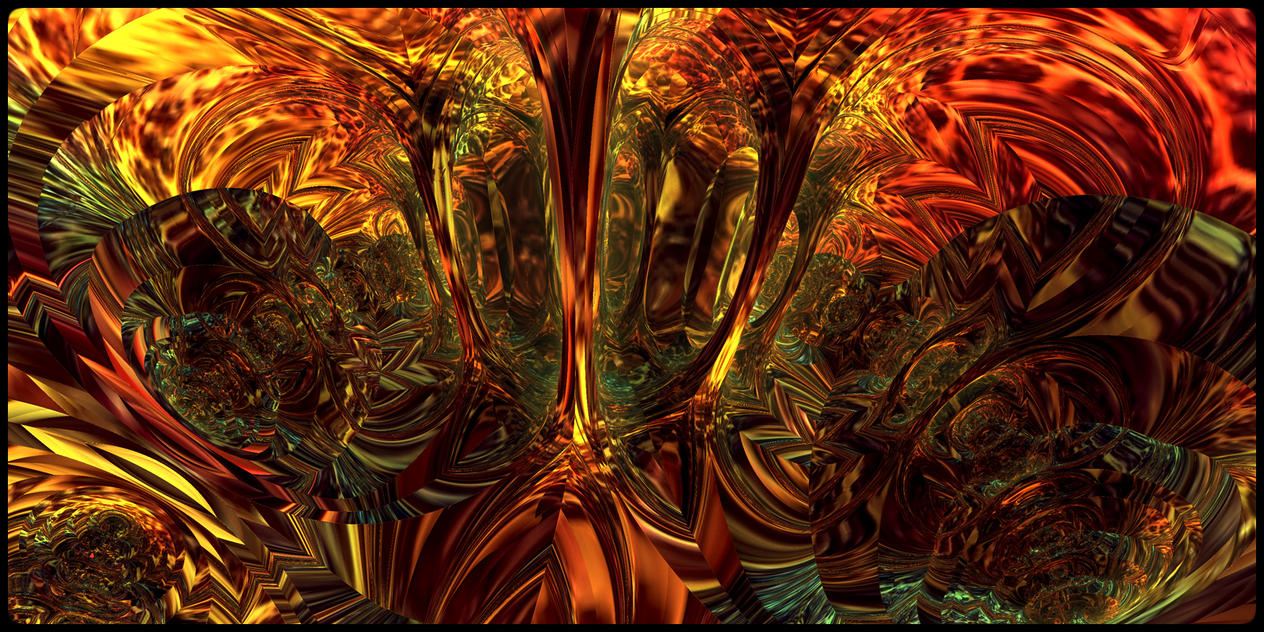

















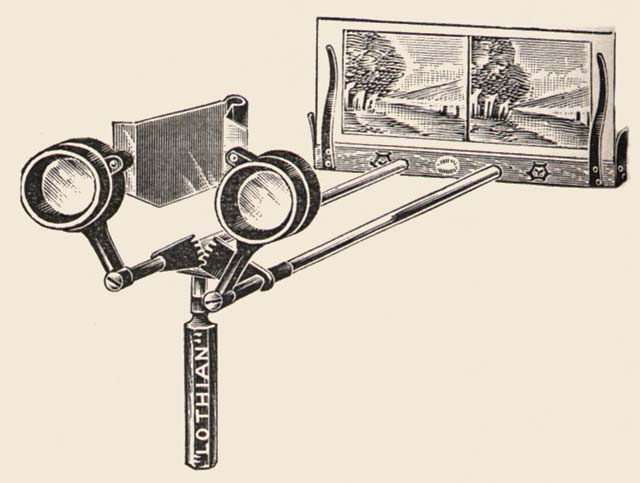
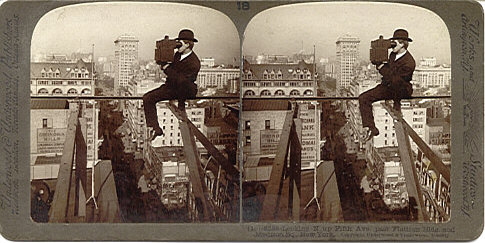



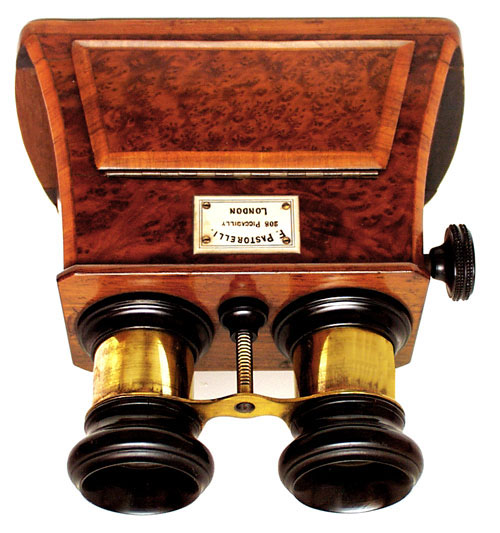
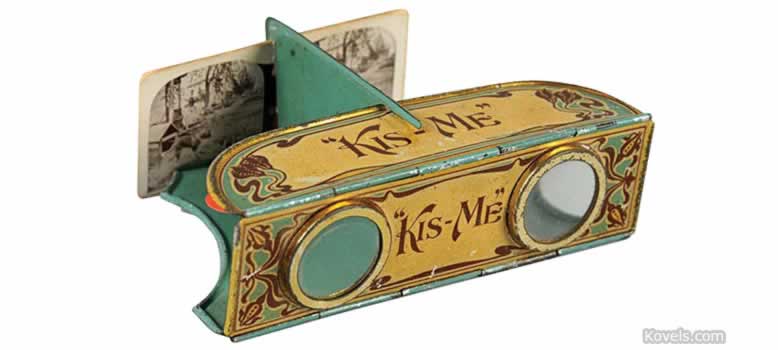


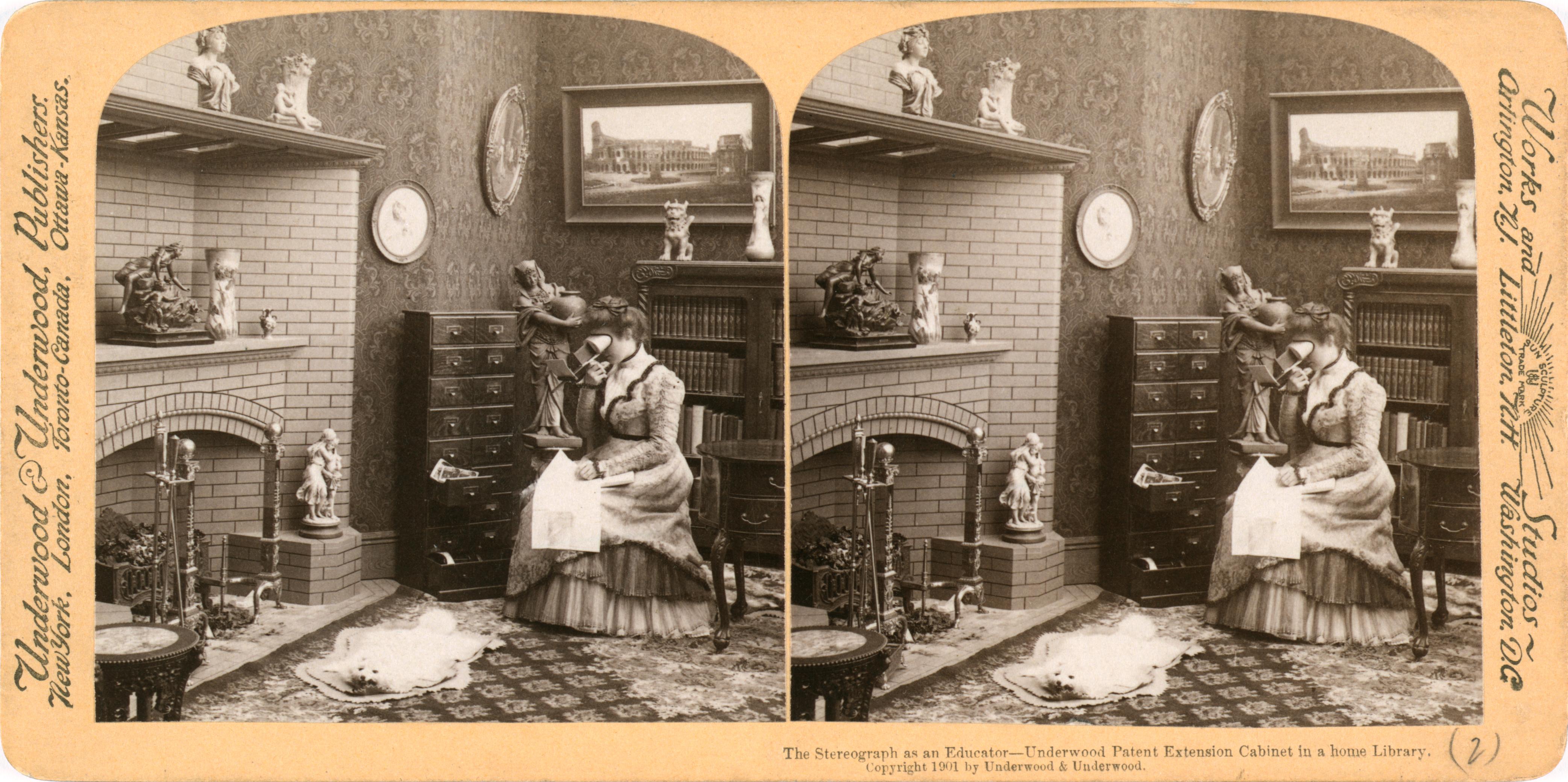




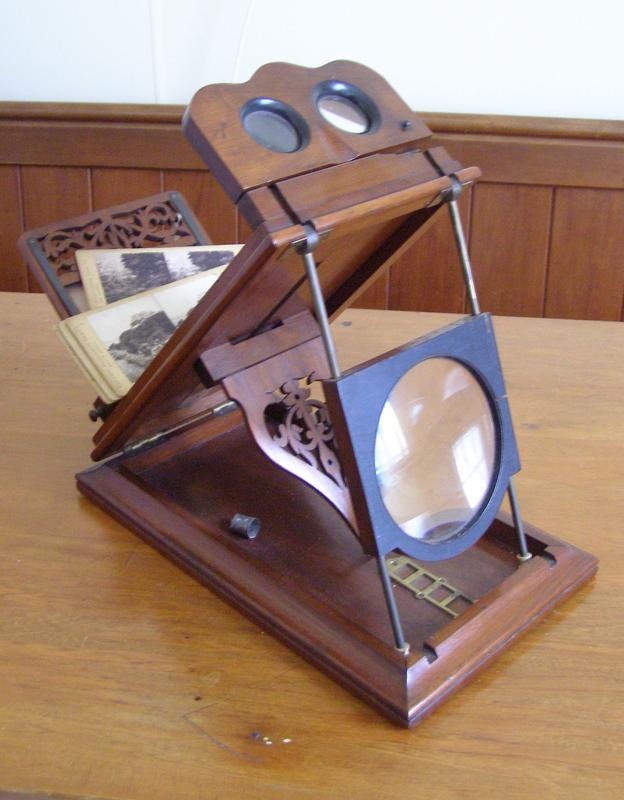

ترجمة و معنى كلمة stereoscope في قاموس المعاني. قاموس عربي انجليزي …
كلمات قريبة
ترجمة و معنى stereoscope في قاموس المعاني. قاموس عربي انجليزي
| مصطلحات | المعنى | النص الاصلى |
| عامة | مجسام | Stereoscope |
| طبية | مِنْظارٌ مُجَسِّم | stereoscope |
| تقنية | استريوسكوب | Stereoscope |
| النقل | منظار جسم | stereoscope |
| الهندسة المدنية | جهاز الاستريوسكوب | Stereoscope device |
كلمات قريبة
| مصطلحات | المعنى | النص الاصلى |
| طبية | تَصْويرٌ شُعاعِيٌّ مُجَسِّم | stereoskiagraphy ( = stereoroentgenography ) |
| عامة | مسجلات | Stereos |
| طبية | تَصْويرُ البوقِ المُجَسِّم | stereosalpingography |
| الامم المتحدة | ستيروسات | Stereosat |
| عامة | مجسامات | Stereoscopes |
| عامة | بشكل تجسيمي | Stereoscopically |
| تقنية | إنتقائية من حيث الفراغية | Stereoselective |
| طبية | مُناوِعٌ فَرَاغِيّ ( صفة للإنزيم) | stereospecific |
| عامة | الاستريوسكوبية – ثلاثيّة الأبعاد؛ مجسامية | Stereoscopy |
| تقنية | الاستريوسكوبية | Stereoscopy |
| الهندسة المدنية | تجسيم التناظر | correspondence stereoscopy |
| عامة | تجسيمي؛ مجسم | Stereoscopic |
| طبية | متعلق بالتَّنْظيرِ المُجَسِّم | stereoscopic |
| طبية | مِقْياسُ السَّاحَةِ البَصَرِيَّةِ المُجَسَّم | stereoscopic campimeter |
| عامة | التصوير السينمائي الاستريوسكوبي | Stereoscopic cinematography |
| طبية | مِجْهَرٌ مُجَسِّم | stereoscopic microscope |
| تقنية | مجهر مجسامي | Stereoscopic microscope |
| تقنية | نموذج مجسم | Stereoscopic model |
| طبية | تَخاطُلٌ مُجَسَّم ( = تَخاطُلُ العَينَين) | stereoscopic parallax ( = binocular parallax ) |
| طبية | قِياسُ الحَوضِ التَّجْسِيمِيّ | stereoscopic pelvimetry |
| عامة | تصوير مجسم | stereoscopic photography |
| عامة | الإسقاط الاستريوسكوبي؛ عرض الأفلام | Stereoscopic projection |
| تقنية | معين مدى مجسامي | Stereoscopic rangefinder |
| تقنية | التثليث المجسم | stereoscopic Triangulation |
| طبية | رُؤْيَةٌ تَجْسِيْمِيَّة | stereoscopic vision |






